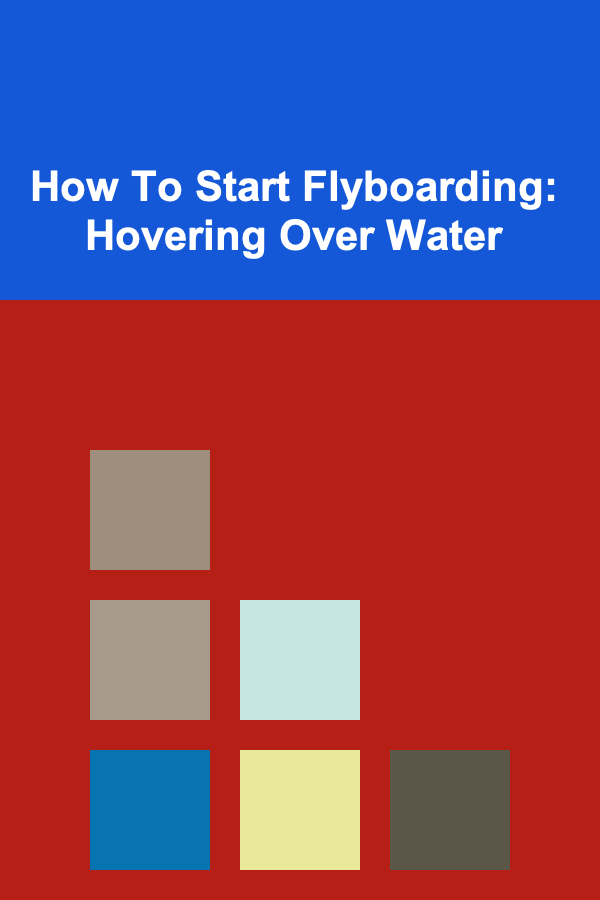
How To Start Flyboarding: Hovering Over Water
ebook include PDF & Audio bundle (Micro Guide)
$12.99$8.99
Limited Time Offer! Order within the next:

Flyboarding, an exciting and relatively new water sport, has captured the imagination of thrill-seekers and adventure enthusiasts worldwide. It combines the thrill of water sports with the excitement of flying, offering a unique experience of hovering above the water with the assistance of a water-powered jetpack. Whether you're a beginner or someone who's looking to learn more about this exciting sport, this guide will help you understand everything you need to know to start flyboarding.
What is Flyboarding?
Flyboarding is an extreme water sport that involves using a flyboard, a device attached to a jet ski, which pushes water through two jet nozzles located at the feet of the rider. This thrust propels the rider up into the air, allowing them to hover, dive, and perform tricks on the water. Flyboards can reach impressive heights, often soaring 10 to 15 feet above the surface of the water, and in some cases, even higher with more experience.
Invented by Franky Zapata, a French jet ski champion, in 2011, the flyboard has evolved into a popular sport for thrill-seekers around the globe. It combines elements of wakeboarding, jet skiing, and even skydiving, making it an exhilarating way to experience water sports.
The Basics of Flyboarding
Before jumping into the process of starting flyboarding, it's important to understand the basic components involved in the sport:
- Flyboard: This is the primary equipment that the rider uses. It's a board with boots for the rider to strap into, and it's attached to the jet ski by a long hose that delivers high-pressure water to the jet nozzles located on the flyboard.
- Jet Ski: A jet ski acts as the power source for the flyboard. It generates the water pressure needed to lift the rider into the air. The jet ski is controlled by a trained operator, who adjusts the throttle to regulate the water pressure and keep the rider airborne.
- Hose: The hose connects the flyboard to the jet ski. Water from the jet ski's pump is sent through the hose and into the flyboard's nozzles. The water pressure from the jet ski determines how high or low the rider can fly.
- Control: The rider controls their movement by shifting their body weight and adjusting their balance. The water pressure can be regulated by the jet ski operator to make the flyboarding experience easier or more challenging.
Step-by-Step Guide to Starting Flyboarding
Flyboarding might seem intimidating at first, but with the right training and knowledge, anyone can do it. If you're eager to hover over the water and experience the thrill of flight, here's a step-by-step guide to help you get started.
Step 1: Understand the Prerequisites
While flyboarding is accessible to beginners, there are a few basic requirements to get started:
- Physical Fitness: Flyboarding requires good core strength, balance, and stamina. It's important to be physically fit and able to maintain control of your body as you fly above the water.
- Swim Skills: Flyboarding is a water sport, and although you will be harnessed and attached to the flyboard, it's still crucial to have basic swimming skills in case you fall into the water.
- Age and Weight Restrictions: Most flyboarding operators have specific age and weight restrictions. Typically, you need to be at least 16 years old, and weigh between 100-300 pounds, depending on the equipment used.
Step 2: Choose the Right Location
Flyboarding requires a body of water with a deep enough depth for safety. While lakes, rivers, and coastal waters are suitable locations, it's important to ensure that the area is clear of obstacles such as boats or debris. Always check with a professional instructor or flyboard operator to ensure the water conditions are safe for the sport.
Step 3: Find a Qualified Instructor
Flyboarding, like any extreme sport, can be dangerous if done incorrectly. It's essential to seek out a professional instructor or operator who is certified to teach flyboarding. Certified instructors will ensure your safety by providing proper guidance, equipment, and support throughout the session.
Step 4: Gear Up for Your First Flight
When you book a flyboarding lesson, you'll be provided with the necessary gear, which typically includes:
- Helmet: A helmet is crucial to protect your head from falls or bumps while flying.
- Life Jacket: A life jacket is an essential safety measure for beginners. It helps to keep you buoyant in case you fall into the water.
- Flyboard Boots: These boots are part of the flyboard and help you stay securely attached while hovering above the water.
Be sure to wear comfortable swimwear, and avoid wearing loose clothing or jewelry that might get caught in the equipment.
Step 5: Getting on the Flyboard
Once you're suited up and ready to fly, the instructor will assist you in getting onto the flyboard. The process typically involves:
- Strapping Into the Flyboard: You'll step into the boots of the flyboard and secure your feet. Make sure they're tight, but not too tight, to avoid discomfort.
- Positioning on the Water: The instructor will position the flyboard in the water, with you standing in an upright position. You'll be instructed to maintain a slight bend in your knees and keep your body weight centered over the board.
Step 6: Launching Into the Air
After you're securely positioned, the jet ski operator will begin to increase the water pressure, slowly lifting you off the water. At this stage, it's important to:
- Stay Calm: It can be daunting to rise above the water, but staying calm and keeping a steady posture will help you maintain balance.
- Keep Your Knees Slightly Bent: Having a slight bend in your knees allows you to absorb the water pressure and maintain better control.
- Control Your Movements: To steer the flyboard, you'll need to shift your weight. Lean forward to move forward, lean back to slow down, and use your feet to control the height.
Step 7: Finding Your Balance
Once you're airborne, balancing on the flyboard is key to maintaining control. It's normal to feel a little wobbly at first, but with practice, you'll become more stable. Some helpful tips for maintaining balance include:
- Engage Your Core Muscles: Keeping your core tight will help stabilize your movements.
- Use Your Feet for Steering: Your feet control the direction and height of your flight. By adjusting your feet, you can hover, move forward, or perform tricks.
- Focus on Small Adjustments: Small shifts in body position and foot movements can make a big difference in controlling the flyboard.
Step 8: Practice and Master Your Skills
Flyboarding, like any sport, requires practice. Once you're comfortable hovering above the water, you can begin practicing different movements, such as:
- Hovering: Maintain a stable position in the air without moving forward or backward. This is the most basic skill, and it's important to master it before attempting anything more advanced.
- Diving and Jumping: By leaning forward, you can dive into the water and then propel yourself back up into the air.
- Spins and Tricks: As you gain more confidence, you can start experimenting with spins, flips, and other aerial tricks.
The more you practice, the more control you'll have over your movements, and the more advanced tricks you'll be able to attempt.
Step 9: Safety First
Safety is always the top priority when flyboarding. Here are some safety tips to keep in mind:
- Listen to Your Instructor: Always follow the guidance of your instructor, especially when you're just starting. They will ensure that you're using the proper techniques to stay safe.
- Don't Overexert Yourself: Flyboarding can be physically demanding, so take breaks if you start feeling fatigued.
- Know When to Stop: If you feel uncomfortable or unbalanced, don't hesitate to signal the instructor to lower the water pressure and bring you back down.
Common Mistakes to Avoid
Like any new skill, flyboarding has a learning curve. Here are some common mistakes beginners make and how to avoid them:
- Not Keeping Your Core Engaged: A weak core can lead to loss of balance, making it harder to control the flyboard.
- Overcompensating with Body Movements: Making large or erratic movements can throw you off balance. Focus on small, controlled adjustments.
- Trying to Go Too High Too Soon: Beginners often want to reach great heights quickly, but it's essential to start small and work your way up gradually.
- Focusing Too Much on Speed: Speed isn't the goal when starting out. Focus on mastering your balance and basic movements before trying to go faster or perform tricks.
Conclusion
Flyboarding is an exhilarating sport that offers a unique experience of hovering above the water. While it might seem challenging at first, with the right equipment, guidance, and practice, anyone can learn how to flyboard. By following the steps outlined in this guide and prioritizing safety, you'll be on your way to mastering this thrilling water sport in no time. Whether you're looking for an adrenaline rush or simply want to try something new, flyboarding is an adventure you won't soon forget.
Reading More From Our Other Websites
- [Home Holiday Decoration 101] How to Make Your Home Festive with DIY Holiday Decorations
- [Scrapbooking Tip 101] How to Customize DIY Scrapbook Templates for Every Occasion
- [Toy Making Tip 101] Seasonal Toy Workshops: Holiday-Themed Creations with Your Cricut Machine
- [Personal Investment 101] How to Understand the Importance of Location in Real Estate
- [Home Family Activity 101] How to Organize a Family Photo Album or Scrapbook
- [Home Soundproofing 101] How to Soundproof a Room Using Thick Curtains and Rugs
- [Stamp Making Tip 101] The Ultimate Toolkit: Essential Materials and Tips for Adult Stamp Makers
- [Needle Felting Tip 101] Step‑by‑Step Techniques: How to Use a Felting Foam Mat for Perfectly Shaped Fibers
- [Home Pet Care 101] How to Set Up a Play Area for Your Pet in Your Home
- [Organization Tip 101] How to Follow Up After Your Yard Sale: Donation and Cleanup

How to Avoid Overspending During Holiday Home Decorations
Read More
How to Build a Checklist for Garden Irrigation System Maintenance
Read More
How to Make the Most of Your Basement with Space-Saving Solutions
Read More
How to Manage Inventory and Keep Your Store Organized
Read More
How to Stage Your Home for Better Photography
Read More
How to Explore Lending and Borrowing Crypto
Read MoreOther Products

How to Avoid Overspending During Holiday Home Decorations
Read More
How to Build a Checklist for Garden Irrigation System Maintenance
Read More
How to Make the Most of Your Basement with Space-Saving Solutions
Read More
How to Manage Inventory and Keep Your Store Organized
Read More
How to Stage Your Home for Better Photography
Read More